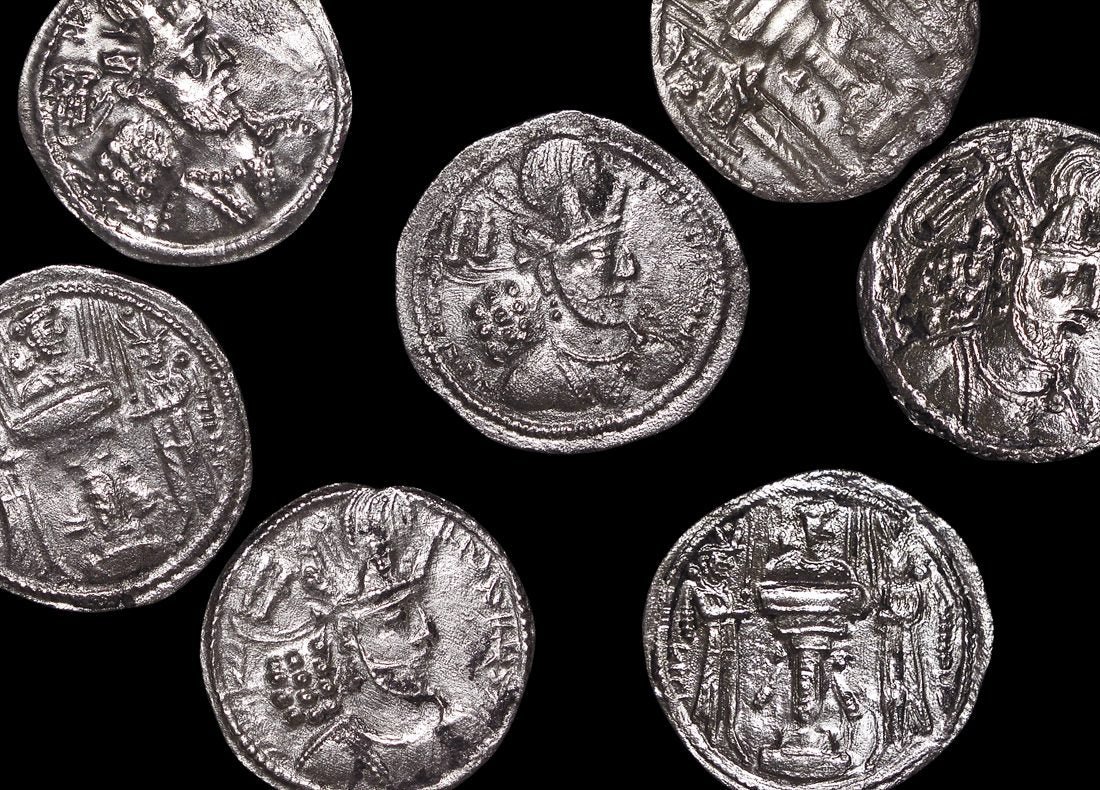 Image 1 of
Image 1 of


Achaemenid Empire Silver Siglos (about 2,500-2,350 years ago)
This silver siglos was issued by the Achaemenid Persian Empire during the reigns of Darius I and his successors from approximately 510-330 BCE. Minted throughout the vast Persian Empire (spanning modern Iran, Iraq, Turkey, and parts of Central Asia), this coin represents one of the world's earliest standardized currency systems established by a major empire.
Coin Description:
Front side: Depicts the "Great King" (Persian emperor) in a half-kneeling or running position, wearing a crown and royal robes, typically carrying a bow in one hand and a spear or dagger in the other, representing the emperor as a warrior.
Back side: Features a simple irregular punch mark or incuse impression rather than a design, a carryover from earlier primitive coinage methods of the region.
Technical Details:
Material: Silver
Denomination: Siglos (the standard silver unit, equivalent to 1/20th of a gold daric)
Minting date/period: c. 510-330 BCE (approximately 2,500-2,350 years ago)
Condition: Varies by specimen
Historical Significance:
This coin represents the economic might of the Achaemenid Empire, the world's first true superpower. Derived from the coinage of Lydia (western Turkey), where coins were first invented, the siglos featured the consistent image of the Persian "Great King" and remained unchanged for nearly two centuries until Alexander the Great's conquest ended the empire. This monetary stability reflected the administrative genius of Darius I, who organized the empire into provinces with standardized taxes, roads, and currency that facilitated trade across three continents.
This silver siglos was issued by the Achaemenid Persian Empire during the reigns of Darius I and his successors from approximately 510-330 BCE. Minted throughout the vast Persian Empire (spanning modern Iran, Iraq, Turkey, and parts of Central Asia), this coin represents one of the world's earliest standardized currency systems established by a major empire.
Coin Description:
Front side: Depicts the "Great King" (Persian emperor) in a half-kneeling or running position, wearing a crown and royal robes, typically carrying a bow in one hand and a spear or dagger in the other, representing the emperor as a warrior.
Back side: Features a simple irregular punch mark or incuse impression rather than a design, a carryover from earlier primitive coinage methods of the region.
Technical Details:
Material: Silver
Denomination: Siglos (the standard silver unit, equivalent to 1/20th of a gold daric)
Minting date/period: c. 510-330 BCE (approximately 2,500-2,350 years ago)
Condition: Varies by specimen
Historical Significance:
This coin represents the economic might of the Achaemenid Empire, the world's first true superpower. Derived from the coinage of Lydia (western Turkey), where coins were first invented, the siglos featured the consistent image of the Persian "Great King" and remained unchanged for nearly two centuries until Alexander the Great's conquest ended the empire. This monetary stability reflected the administrative genius of Darius I, who organized the empire into provinces with standardized taxes, roads, and currency that facilitated trade across three continents.
This silver siglos was issued by the Achaemenid Persian Empire during the reigns of Darius I and his successors from approximately 510-330 BCE. Minted throughout the vast Persian Empire (spanning modern Iran, Iraq, Turkey, and parts of Central Asia), this coin represents one of the world's earliest standardized currency systems established by a major empire.
Coin Description:
Front side: Depicts the "Great King" (Persian emperor) in a half-kneeling or running position, wearing a crown and royal robes, typically carrying a bow in one hand and a spear or dagger in the other, representing the emperor as a warrior.
Back side: Features a simple irregular punch mark or incuse impression rather than a design, a carryover from earlier primitive coinage methods of the region.
Technical Details:
Material: Silver
Denomination: Siglos (the standard silver unit, equivalent to 1/20th of a gold daric)
Minting date/period: c. 510-330 BCE (approximately 2,500-2,350 years ago)
Condition: Varies by specimen
Historical Significance:
This coin represents the economic might of the Achaemenid Empire, the world's first true superpower. Derived from the coinage of Lydia (western Turkey), where coins were first invented, the siglos featured the consistent image of the Persian "Great King" and remained unchanged for nearly two centuries until Alexander the Great's conquest ended the empire. This monetary stability reflected the administrative genius of Darius I, who organized the empire into provinces with standardized taxes, roads, and currency that facilitated trade across three continents.
























